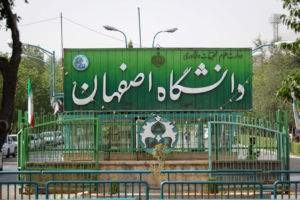University of Isfahan
As the oldest and largest university offering the highest number of fields of study, the University of Isfahan is a state university affiliated to the Ministry of Science, Research, and Technology. Located in the center of Iran, the first foundations of this university were laid in 1947 with the founding of Isfahan Higher School of Health. This school began its work with the cooperation of a number of assistant professors in a humble house located in Ahmedabad street. After a short time, it was moved to the northern building of Sa’adi High School, which had a relatively well-equipped laboratory at that time. This laboratory was then used by the students of the Higher School of Health.
Four years after that (i.e. in 1951), Isfahan College of Medicine was established close to the aforesaid school. This college continued its educational activity by organizing a six-year academic course to offer the doctorate diploma in medicine for the students upon completion of a thesis. In this way, the Higher School of Health was gradually closed down with its professors having been transferred to the College of Medicine. Thereafter, a number of qualified physicians were hired for teaching purpose.
In the 1956-1957 academic year, the College of Pharmacy was founded and joined to the College of Medicine. As a result, its classes and laboratories whose related buildings have been rented scatteredly in the city were used.
In 1959, the College of Pharmacy became an independent unit. In the same year, the permission for the establishment of the College of Literature in Isfahan was issued. This college officially kicked off its educational activities on December 9, 1958. Upon the addition of the College of Literature to the existing Colleges of Medicine and Pharmacy, the University of Isfahan came into existence whose chancellor was appointed on December 16 of the same year.
In the academic year of 1962-1963, the secretariat of University of Isfahan was dissolved and the Colleges of Literature and Medicine became independent units operating under the supervision of the then General Directorate of the Higher Education of the Ministry of Culture. In the 1962-1963 academic year, the College of Pharmacy re-joined the College of Medicine. Hence, admission of the students to the College of pharmacy was halted and the remaining pharmacy students were sent to the Tehran’s College of Pharmacy.
In August 1964, the College of Science was founded adjacent to the College of Literature and commenced its educational activities.
In October 1965, the Isfahan University of Higher Education was built next to the Colleges of Literature and Science, simultaneously with Ahvaz, Tabriz, and Mashhad Universities of Higher Education. Its academic existence began on September 7, 1967 upon the appointment of the new chancellor of the University of Isfahan. From that date, the organization of the university took a new form and various buildings for the constituent colleges were constructed in the university area located on Hezar Jarib avenue and the necessary facilities were also added to them.
During the 1968-1969 academic year, the evening course was inaugurated in the University of Isfahan. In the same year, Isfahan University of Higher Education was expanded by a wider organization and a more complete program, initiating its activities under the name of the College of Educational Sciences. Further, its academic period was increased from two to four years.
Horticulture Institute was set up in 1973. This institute was transferred to Isfahan University of Technology (IUT) in 1977 and presently continues to operate under the name of College of Agriculture there. In 1976, the former Kourosh Higher School was officially handed over to the University of Isfahan. From then on, it formally kicked off its educational activities under the name of the College of Administrative Sciences and Economics.
Already operating in the College of Literature, the College of Foreign Languages started working in 1976.
In 1986, master’s courses in economics, geography, mathematics, geology, biology, chemistry, educational sciences, and physics were offered in the University of Isfahan. Meanwhile, in the same year, the Colleges of Health, Nursing, Medicine, Pharmacy, and Dentistry were separated from the University of Isfahan to be transferred to the Isfahan University of Medical Sciences. In 1988, the College of Engineering was set up in two fields of Computer Engineering (Hardware-Software) and Civil Engineering (Surveying).
In 1990, the mathematics doctoral course was initiated in the University of Isfahan. The mentioned course has started its activities from the academic year 1992-1993. Also, in 1992, the doctoral course in Geography and the College of Physical Education and Sports Sciences were instated, respectively. As a result, the Department of Physical Education was transferred from the College of Educational Sciences to this newly inaugurated college.
With its 70-year history and as the largest university in the center of the country, the University of Isfahan glitters on the brow of Isfahan- one of the most glorious cities of God. Over one hundred thousand graduates of this university have effectively served in the key national positions.
To realize the future horizon of the University of Isfahan, a clear roadmap with significant plans has been envisaged. The following are among the most important approved missions of the strategic plan of this university:
– Pushing the development of the knowledge borders, transformation of knowledge into technology, and wealth generation;
– Responding to the scientific needs of the society in line with the sustainable development; and
– Continuing the effective presence in the national and international arena.
Drawing upon the scientific capacity of over 650 faculty members and by training more than 15,000 students in 71 fields of study at bachelor’s degree, 185 fields of study at the master’s degree, and 119 fields at the doctoral degree, the University of Isfahan currently plays a vital role in promoting the scientific, cultural, and social atmosphere of the society.

